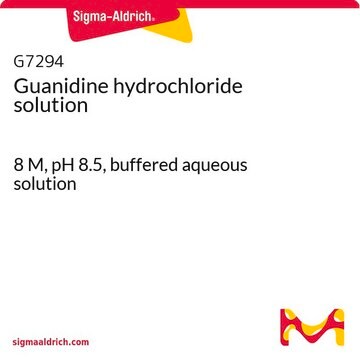Kluczowe dokumenty
50950
Guanidine hydrochloride
≥98%
Synonim(y):
Aminoformamidine hydrochloride, Aminomethanamidine hydrochloride, Guanidinium chloride
About This Item
Polecane produkty
Próba
≥98%
Formularz
powder or crystals
warunki przechowywania
(Tightly closed. Dry. )
kolor
colorless to white
pH
(25 °C, 4.6 - 6/573 g/L)
mp
180-185 °C (lit.)
rozpuszczalność
H2O: 6 M, clear (100 Hazen)
gęstość
1.3 g/cm3 (lit.)
ciąg SMILES
Cl[H].NC(N)=N
InChI
1S/CH5N3.ClH/c2-1(3)4;/h(H5,2,3,4);1H
Klucz InChI
PJJJBBJSCAKJQF-UHFFFAOYSA-N
informacje o genach
human ... KCNA1(3736) , KCNA10(3744) , KCNA2(3737) , KCNA3(3738) , KCNA4(3739) , KCNA5(3741) , KCNA6(3742) , KCNA7(3743) , KCNB1(3745) , KCNB2(9312) , KCNC1(3746) , KCNC2(3747) , KCNC3(3748) , KCNC4(3749) , KCND1(3750) , KCND2(3751) , KCND3(3752) , KCNF1(3754) , KCNG1(3755) , KCNG2(26251) , KCNG3(170850) , KCNG4(93107) , KCNH1(3756) , KCNH2(3757) , KCNH3(23416) , KCNH4(23415) , KCNH5(27133) , KCNH6(81033) , KCNH7(90134) , KCNH8(131096) , KCNQ1(3784) , KCNQ2(3785) , KCNQ3(3786) , KCNQ4(9132) , KCNQ5(56479) , KCNS1(3787) , KCNS2(3788) , KCNS3(3790) , KCNV1(27012) , KCNV2(169522)
Szukasz podobnych produktów? Odwiedź Przewodnik dotyczący porównywania produktów
Powiązane kategorie
Opis ogólny
At lower concentrations, guanidine hydrochloride has the intriguing ability to promote the refolding of denatured proteins, aiding in protein renaturation studies. In RNA extraction, it acts as a strong denaturant, disrupting cell structures and ensuring the integrity of extracted RNA by inactivating RNA enzymes. Overall, guanidine hydrochloride′s denaturing and renaturing properties make it an essential reagent for various cell biology applications, including protein purification, nucleic acid isolation, and protein refolding studies.
Zastosowanie
- for lysing homogenized brain tissue
- in the preparation of incubation buffer for Ni-sepharose protein binding, purification, propionylation, and on-bead digestion to minimize nonspecific binding to the affinity resin
- in the preparation of solutions/extraction buffer to extract soluble protein from the human tissue
Działania biochem./fizjol.
Cechy i korzyści
Inne uwagi
Hasło ostrzegawcze
Warning
Zwroty wskazujące rodzaj zagrożenia
Zwroty wskazujące środki ostrożności
Klasyfikacja zagrożeń
Acute Tox. 4 Inhalation - Acute Tox. 4 Oral - Eye Irrit. 2 - Skin Irrit. 2
Kod klasy składowania
11 - Combustible Solids
Klasa zagrożenia wodnego (WGK)
WGK 1
Temperatura zapłonu (°F)
Not applicable
Temperatura zapłonu (°C)
Not applicable
Środki ochrony indywidualnej
dust mask type N95 (US), Eyeshields, Faceshields, Gloves
Wybierz jedną z najnowszych wersji:
Masz już ten produkt?
Dokumenty związane z niedawno zakupionymi produktami zostały zamieszczone w Bibliotece dokumentów.
Klienci oglądali również te produkty
Nasz zespół naukowców ma doświadczenie we wszystkich obszarach badań, w tym w naukach przyrodniczych, materiałoznawstwie, syntezie chemicznej, chromatografii, analityce i wielu innych dziedzinach.
Skontaktuj się z zespołem ds. pomocy technicznej





